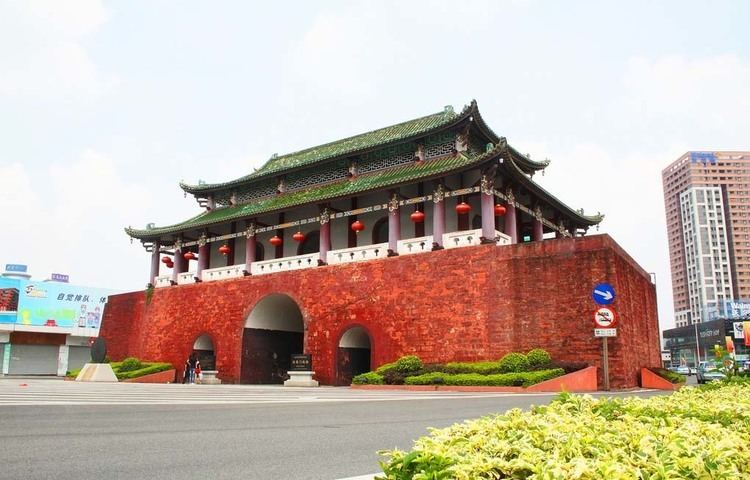Country China Time zone China Standard (UTC+8) Local time Saturday 2:32 PM | Population (2013 census:) 165,800 Area 13.5 km² | |
 | ||
Website 文化莞城 guancheng.dg.gov.cn/index.php/c.html Weather 19°C, Wind NE at 3 km/h, 87% Humidity | ||
Guancheng Subdistrict (Chinese:莞城街道; pinyin: Guǎnchéng Jiēdào, "City of Scirpus, a genus of sedges") is a subdistrict in Guangdong Province, China under the administration of Dongguan City. It has an area of 13.5 square kilometres (5.2 sq mi) and a residential population of 230,000, of which 152,000 are new residents. Guancheng was the old political and cultural centre of Dongguan, before the government moved to the new centre in the Nancheng Subdistrict.
Contents
- Map of Guancheng Residential District Dongguan Guangdong China 523000
- Introduction
- Political leadership
- Commercial business districts CBD
- Medical and health
- Education
- Cultural relics
- Gallery
- References
Map of Guancheng Residential District, Dongguan, Guangdong, China, 523000
Introduction
Guancheng Subdistrict in Dongguan City has a history of some 1300 years, stretching back to 757 AD in the Tang Dynasty. Many culture relics remain. The Ke Yuan (可园) is the most famous Chinese garden in Guangdong. The gate tower, Ying'en Men (迎恩门), was built in the Ming Dynasty and has a history of more than 600 years. The Quejin Stele (却金碑) is a good scenic spot in Dongguan City, which bears testament to the Chinese people's sense of justice and probity when they had trade relations with Thailand during the Ming Dynasty.
Guancheng Subdistrict gathers talented people, fortune and information together. It's a subdistrict connected with both traditional and modern trade, which provides a stage for secondary industries. It is located to the mid-west of Dongguan City and the northeast of the Pearl River Delta, on the route between Guangdong and Hong Kong.
Political leadership
Guancheng Subdistrict used to be the political center of Dongguan City. The following is the list of political office-holders of Guancheng Sbudistrict:
Commercial business districts (CBD)
Guancheng Subdistrict's three important business districts are:
Medical and health
Guancheng Subdistrict is the center for medical and health services in Dongguan City. There are many large integrated medical institutions, including:
Education
Guancheng Subdistrict is located in the center of downtown Dongguan, which is an educational, political and economic area, and has long cultural history. There are a university, 3 senior high schools, 3 technical secondary schools, 8 primary schools and 19 kindergartens. Among these schools, there is the best senior high school with hundreds years. Also, the only one university with high level science and engineering university locates in Guancheng Subdistrict.
Educational institutions of Guancheng Subdistrict include:
Cultural relics
This stele is located on Guangming Road outside the North Gate of Guancheng Subdistrict. It was established from 1541, Ming Dynasty Jiajing. It is well-preserved. Quejin Stele recorded Li Kai, the Yin (县尹) of Panyu County (番禺县), dealing with the businessmen from Siam (now Thailand) without any payment during Ming Jiajing. This stele was made from bluestone with a hard texture. The stele is 143 centimetres (56 in) long, 30 centimetres (12 in) wide and 20 centimetres (7.9 in) high with a red-sandstone rectangular base.
Established 1921, Ouge Arbours lies on the west side of Yu Mountain in Dongguan People's Park. The arbours sitting southeast-to-northwest, 7.7 metres (25 ft) wide, 6.5 metres (21 ft) deep and 7.8 metres (26 ft) high. Ouge Arbours was in honour of Huang Chunlin, the head of Dongguan County, and was built by the local people to mark the many good works he did. In 2008, the managers of the park repaired the arbours according to its original sample and installed stone tables and stools for tourists.
Daosheng Park was built by Zhang Jiamo, the nephew of Ke Yuan founder Zhang Jingxiu. It stands in Daofu Alley of Guancheng Subdistrict. The whole park sat northwest-to-southeast. Ju Chao (居巢) and Ju Lian (居廉) have lived in this park for about 10 years, where they founded the Ling-nan School of painters. The original area of Daosheng Park was about 750 kilometers. However, after hundreds of years, there were only several old and shabby houses.
Gallery
Guancheng Subdistrict is the Old Town of Dongguan City. Here are some of its sights:
